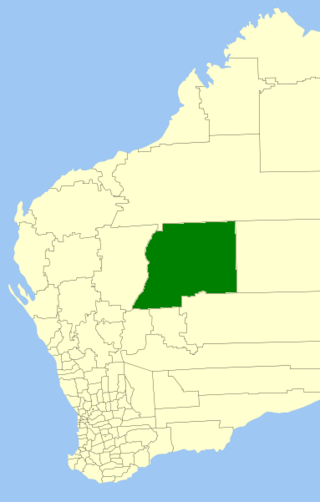
The City of Kwinana is a local government area of Western Australia. It covers an area of approximately 118 square kilometres in metropolitan Perth, and lies about 38 km south of the Perth central business district, via the Kwinana Freeway. Kwinana maintains 287 km of roads and had a population of almost 39,000 as at the 2016 Census.

Baldivis is a semi-rural residential suburb 46 kilometres (29 mi) south of Perth, Western Australia, and 11 kilometres (6.8 mi) southeast of the regional centre of Rockingham. It is located within the City of Rockingham local government area.

East Rockingham is an industrial suburb within the Kwinana Industrial Area, part of Perth, and located within the City of Rockingham.

The Shire of Waroona is a local government area in the Peel region of Western Australia between Mandurah and Harvey and about 110 kilometres south of Perth, the state capital. The Shire covers an area of about 835 km2 (322 sq mi) and its seat of government is the town of Waroona.

The City of Rockingham is a council and local government area, comprising the south coastal suburbs of the Western Australian capital city of Perth.

The Shire of Wiluna is a local government area in the Goldfields-Esperance region of Western Australia, about 950 kilometres (590 mi) northeast of the state capital, Perth. The Shire covers an area of 182,155 square kilometres (70,330 sq mi), and its seat of government is the town of Wiluna.
Meelon is a small townsite in the Peel region of Western Australia, located between Pinjarra and Dwellingup within the Shire of Murray. At the 2011 census, Meelon had a population of 224.
Brookton to Corrigin railway was a railway line in the Wheatbelt region of Western Australia, between Brookton and Corrigin.

Yangebup Lake is a freshwater lake in the suburb of Yangebup, 18 kilometres (11 mi) south-west of the central business district of Perth, the capital of Western Australia. It is part of Beeliar Regional Park.

The Peel Main Drain is a drainage canal in the southern suburbs of Perth, Western Australia. Construction of the canal commenced in 1920 to drain the wetlands in the area as part of the post-World War I Group Settlement Scheme at the Peel Estate. The canal stretches from Banjup, where it starts just north of Banjup Lake, to Karnup, where it discharges into the Serpentine River. The drain has a catchment area of 120 square kilometres.

The Peel Estate was an area of land in the south of Perth, Western Australia, predominantly in what is now the City of Kwinana, City of Rockingham and the Shire of Serpentine–Jarrahdale. The estate twice featured prominently in Western Australian history.

The Spectacles Wetlands is a wetland located in the eponymous suburb, 30 kilometres (19 mi) south of the central business district of Perth, the capital of Western Australia. It is part of Beeliar Regional Park.

The Merredin to Narrogin railway line was a railway line in the Wheatbelt region of Western Australia, between Merredin and Narrogin. The line was also known as the West Merredin to Narrogin via Corrigin railway.
The Wagin to Bowelling railway line was a state government-owned and WAGR-operated railway line in the Wheatbelt region of Western Australia, connecting Wagin via Bokal to Bowelling. The line was 102 kilometres (63 mi) long. At Wagin, the railway line connected to the Great Southern Railway and the Wagin to Newdegate railway line while, at Bowelling, it connected to the Brunswick Junction to Narrogin railway line.
The Upper Chapman Valley railway line was a 61-kilometre (38 mi) long state government-owned and WAGR-operated railway line in the Mid West region of Western Australia, connecting Wokarina, a siding on the Northampton railway line at Glenfield, to Yuna.

The Avon Yard to Mullewa railway line is a 429-kilometre (267 mi) long railway line operated by Arc Infrastructure in the Mid West and Wheatbelt regions of Western Australia, connecting the Avon Yard at Northam with Mullewa. The 104-kilometre (65 mi) section of the railway line from Perenjori to Dalwallinu is, as of 2024, not in operation, having closed in the late 1990s, while the sections north, Perenjori to Mullewa, and south, Dalwallinu to Northam, are.

The Amery to Kalannie railway line is a 98-kilometre (61 mi) long railway line operated by Arc Infrastructure in the Wheatbelt region of Western Australia, connecting Amery with Kalannie.

The Jarrahdale to Rockingham railway line was a private timber railway line connecting the timber mill at Jarrahdale with the port at Rockingham. It was the second railway line to operate in Western Australia, opening in 1872. From 1893, it connected to the South Western Railway at Mundijong. The section from Mundijong to Rockingham was removed in 1950 but the Jarrahdale to Mundijong section remained in operation until 1962.
Collins is a rural locality of the Shire of Manjimup in the South West region of Western Australia. The South Western Highway forms the north-eastern border of the locality while the Vasse Highway runs along its north-western one. The Warren River forms the entire eastern and southern border of Collins. Small sections of the Sir James Mitchell and Gloucester National Park are also located within the locality.
Crowea is a rural locality of the Shire of Manjimup, located near Northcliffe, in the South West region of Western Australia. The South Western Highway forms the eastern border of the locality while the Warren River forms most of its northern border. Parts of the Greater Hawke National Park, in the west, and Greater Dordagup National Park, in the east, are located in Crowea while a small section of Jane National Park penetrates into the south of the locality.














